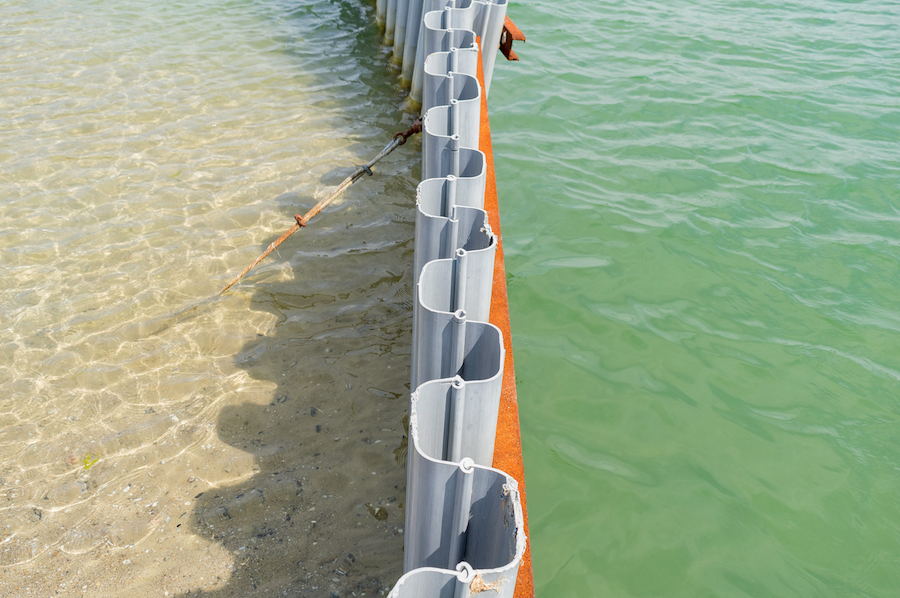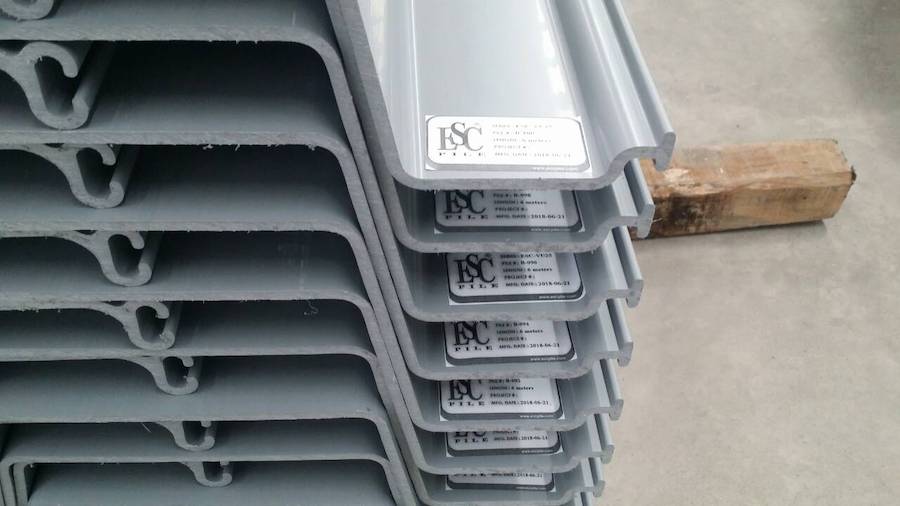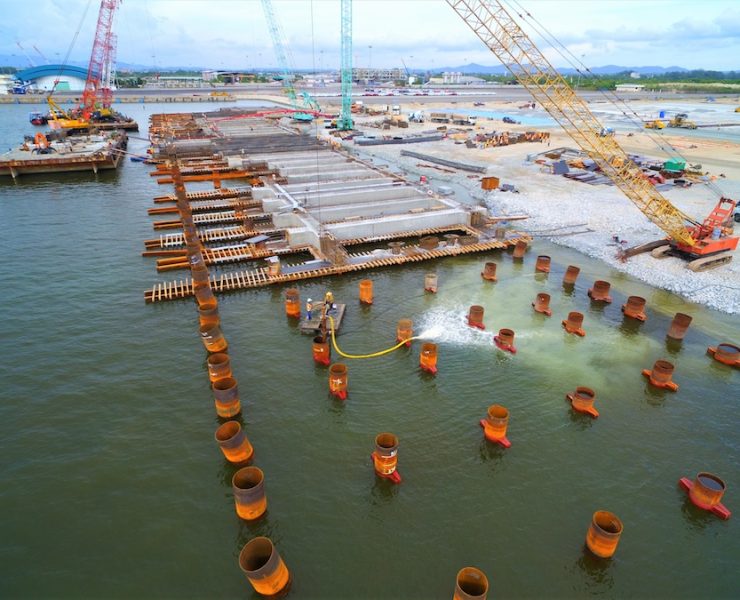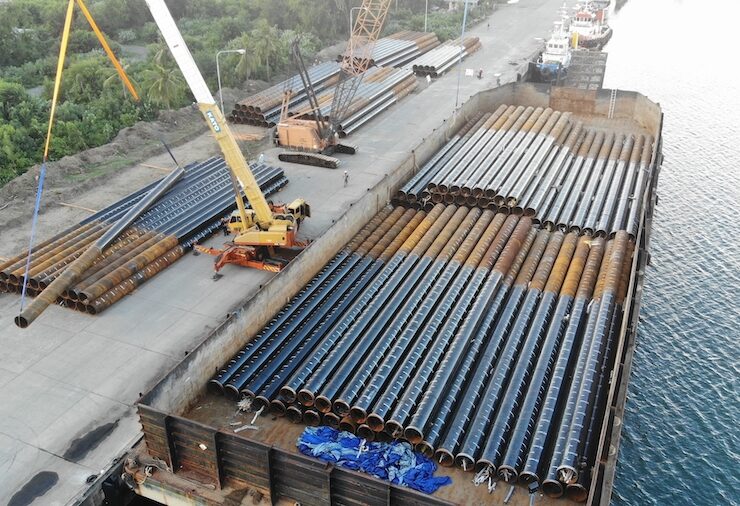Thoughts on Vinyl Sheet Piling


View the complete article here.
As the demands of modern construction have changed, so too have the materials contractors use. Enter vinyl sheet piling. Vinyl, a synthetic plastic material known for its durability and resistance to environmental factors, has emerged as a formidable alternative to traditional sheet piling materials like steel and wood.
Origins of Vinyl Sheet Piling
Vinyl, or polyvinyl chloride (PVC), has a rich history dating back to the 19th century, however, its role in sheet piling is relatively recent. By the mid to late 20th century, as the drawbacks of traditional materials like timber (decay, marine borer attacks) and steel (corrosion) became increasingly evident, the search for alternatives gained momentum. Vinyl, with its inherent resistance to many environmental threats, presented a promising option.
The first vinyl sheet piles appeared in the market around the 1980s, offering an almost maintenance-free alternative to materials that had dominated the industry for decades. The adoption of vinyl sheet piles began to progress, especially in marine construction projects where long-term durability without intensive maintenance was a priority.
However, like any innovation, the introduction of vinyl sheet piling wasn’t without its challenges. There were initial reservations regarding the material’s strength and load-bearing capacity, especially when compared to its steel counterpart. Skeptics questioned whether vinyl could withstand the extreme pressures in certain construction scenarios.
Another challenge lay in the perception of vinyl. Being relatively new to the construction scene, it had to prove itself not just in terms of durability but also in environmental safety. Concerns about the production, recycling, and disposal of vinyl and its impact on the environment were prevalent.
Yet, with challenges came solutions. Over the years, advancements in the formulation of vinyl and improvements in the design of the interlocking system greatly enhanced its structural capabilities. Furthermore, hybrid solutions emerged—where vinyl was combined with other materials, like steel or fiberglass reinforcements, to boost its load-bearing capacities.
On the environmental front, the industry took strides to produce vinyl in more eco-friendly ways—reducing emissions and waste. Efforts were also made to increase the recyclability of vinyl, addressing concerns about its life cycle and ecological footprint.
Advantages of Using Vinyl for Sheet Piling
Vinyl sheet piling, over the years, has carved a niche for itself in the construction and engineering sectors. This acceptance stems from the range of advantages it offers, both from a practical and economic perspective.
Durability and Resistance
One of the standout qualities of vinyl is its exceptional resistance to corrosion—especially in saltwater environments where metals like steel face degradation. This makes vinyl an ideal choice for maritime and coastal projects.
Exposure to the sun’s ultraviolet rays can degrade many types of materials over time. However, vinyl sheet piles are engineered to be UV resistant—ensuring they maintain their structural integrity and appearance for extended periods.
Economic Benefits
Given its durability and resistance to environmental factors, vinyl sheet piling tends to have a longer lifespan compared to traditional materials. This extended life reduces the frequency, and thus the cost, of replacements.
One of the significant cost benefits of vinyl is the minimal maintenance it requires. Unlike steel, which might need periodic treatments to prevent corrosion—or wood, which can rot or be attacked by marine species—vinyl remains relatively unaffected, leading to long-term savings.
Aesthetics and Flexibility
Vinyl offers a range of colors and finishes, allowing for more aesthetic choices compared to steel and wood. This variety ensures that the sheet piles can be visually aligned with the project’s design or the surrounding environment.
Beyond mere aesthetics, vinyl sheet piling offers flexibility in design. This material can be molded and manufactured to fit custom project requirements—be it specific lengths, shapes, or interlocking mechanisms—ensuring optimal fit and function for diverse projects.
Limitations and Concerns
Of course, every innovation—every material—has its drawbacks.
Potential Limitations in Load-Bearing Capacity Compared to Steel
While vinyl sheet piling offers numerous advantages, it’s essential to acknowledge its load-bearing limitations—especially when juxtaposed with steel. Steel, a dense and robust material, inherently possesses a higher tensile strength and load-bearing capacity. In heavy-duty applications where substantial lateral forces or high impact loads are anticipated, steel sheet piles are often preferred. Engineers and project planners need to carefully evaluate the project’s requirements to determine whether vinyl’s load-bearing capacity is sufficient or if a more robust material like steel is warranted.
Environmental Concerns Over the Production and Disposal of Vinyl
The production of vinyl, or polyvinyl chloride (PVC), has raised environmental eyebrows over the years. The manufacturing process can result in the release of dioxins, which are harmful to both the environment and human health. Moreover, concerns about the release of toxic additives used in PVC—like phthalates or lead stabilizers—have also been voiced. Furthermore, while vinyl is touted as being recyclable, the presence of these additives can complicate recycling processes—leading to challenges in its effective disposal. It’s crucial for the industry to continue its efforts in reducing the environmental impact of vinyl production and ensuring safer disposal or repurposing methods.
Considerations Regarding Extreme Temperatures and Vinyl’s Performance
Vinyl sheet piling, like many plastic-based materials, can exhibit performance changes under extreme temperature conditions. In very cold climates, vinyl may become more brittle—leading to concerns about its impact resistance. Conversely, in high-temperature environments, there might be issues related to the material softening or warping. While modern vinyl formulations have been developed to be more temperature-resistant, it’s still vital for project planners to assess the local climatic conditions and determine if vinyl is the appropriate choice—especially in regions prone to temperature extremes.
Installation Best Practices for Vinyl Sheet Piling
Proper pre-treatment of soils, using the right tools, and adhering to safety guidelines are all pivotal in ensuring the successful installation of vinyl sheet piling.
Pre-Treatment of Soils and Site Preparation
Before installing vinyl sheet piling, it’s imperative to ensure that the soil and the site are adequately prepared. This not only facilitates smoother installation but also enhances the long-term performance of the pile.
- Soil testing: Begin by conducting a thorough soil analysis. Understanding the soil composition helps in determining its load-bearing capacity and informs the depth to which sheet piles need to be driven.
- Clearing the site: Remove any debris, vegetation, or obstacles from the installation area. This step ensures a clean working space and prevents unforeseen complications during installation.
- Leveling: Depending on the site’s condition, it might be necessary to level the ground. This step aids in uniform driving of the sheet piles and prevents any misalignment.
- Marking: Clearly demarcate the area where the piles will be driven, using chalk or marker stakes. This ensures accuracy and alignment during installation.
Recommended Tools and Equipment
The right tools can significantly streamline the vinyl sheet piling installation process.
- Vibratory hammer: Especially useful for driving vinyl sheet piles into denser soils, this tool reduces manual labor and ensures deeper, more secure placement.
- Manual or hydraulic press: For softer grounds or areas where noise and vibration need to be minimized, these presses can be employed.
- Interlocking tool: This assists in correctly aligning the vinyl sheet piles, ensuring they interlock seamlessly.
- Pile guide: Helps to maintain alignment during the driving process.
- Excavator (if necessary): In cases where pre-digging is required, a suitable excavator should be on hand.
Final Thoughts
Vinyl’s resistance to environmental factors, longevity, and minimal maintenance requirements have solidified its place as a compelling option—especially for certain marine and coastal projects. However, while vinyl’s merits are manifold, it’s important to acknowledge that for projects demanding superior strength—particularly those of a larger scale—steel remains the gold standard. When considering the different sheet piling options for a project, it’s essential to weigh vinyl’s strengths against its limitations—ensuring the chosen material aligns with the project’s unique demands and scope.
View the complete article here.
What are the advantages of using vinyl sheet piling over traditional materials like steel and wood?
Vinyl sheet piling offers exceptional resistance to corrosion, UV resistance, economic benefits, aesthetic flexibility, and minimal maintenance compared to traditional materials.
What are the limitations and concerns associated with vinyl sheet piling?
Vinyl sheet piling may have limitations in load-bearing capacity compared to steel, environmental concerns over production and disposal, and considerations related to its performance under extreme temperatures.


















